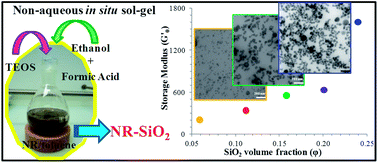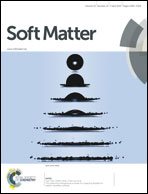A novel non-aqueous sol–gel route for the in situ synthesis of high loaded silica–rubber nanocomposites†
Abstract
Silica–natural rubber nanocomposites were obtained through a novel non-aqueous in situ sol–gel synthesis, producing the amount of water necessary to induce the hydrolysis and condensation of a tetraethoxysilane precursor by esterification of formic acid with ethanol. The method allows the synthesis of low hydrophilic silica nanoparticles with ethoxy groups linked to the silica surface which enable the filler to be more dispersible in the hydrophobic rubber. Thus, high loaded silica composites (75 phr, parts per hundred rubber) were obtained without using any coupling agent. Transmission Electron Microscopy (TEM) showed that the silica nanoparticles are surrounded by rubber layers, which lower the direct interparticle contact in the filler–filler interaction. At the lowest silica loading (up to 30 phr) silica particles are isolated in rubber and only at a large amount of filler (>60 phr) the interparticle distances decrease and a continuous percolative network, connected by thin polymer films, forms throughout the matrix. The dynamic-mechanical properties confirm that the strong reinforcement of the rubber composites is related to the network formation at high loading. Both the improvement of the particle dispersion and the enhancement of the silica loading are peculiar to the non-aqueous synthesis approach, making the method potentially interesting for the production of high-loaded silica–polymer nanocomposites.


 Please wait while we load your content...
Please wait while we load your content...